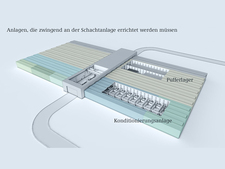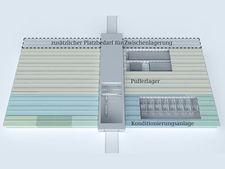-
Topics
subnavigation
Topics
What happens in the Asse?
What will become of the Asse?
The need for an interim storage facility
Constrution of an interim storage facility with conditioning plant (surface facilities)
An interim storage facility is the precondition for the retrieval of the radioactive waste from the Asse mine to be successful. For as long as there is no suitable repository for the recovered waste, the Federal Office for Radiation Protection needs to store the waste packed in special types of containers intermediately.
When all elements are in place to recover the radioactive waste from the mine, the procedure is far from being completed. Although the radioactive waste is already packed into safety containers when it is hauled to the surface, it has to be repacked into additional containers and sealed in a manner that it is suitable for disposal (conditioned). In order to be able to pack and store the waste, the necessary facilities need to be constructed at the surface. Only when this infrastructure will be in place, can retrieval operations start.
The following is required:

![]() Facilities which need to be constructed in the near vicinity of the mine (buffer facility in the background; conditioning plant in the front)
Facilities which need to be constructed in the near vicinity of the mine (buffer facility in the background; conditioning plant in the front)
- a buffer facility (for recovered waste which has not yet been packed in a manner suitable for disposal)
- a conditioning plant (where the waste is packed in a manner suitable for disposal and transportation),
- an interim storage facility (for conditioned waste until it is taken to a repository)
- as well as all equipment needed for the operation and security of the facilities.
For these facilities the Federal Office for Radiation Protection (BfS) needs to find a suitable location. After a balanced assessment of the various factors, the BfS has come to the conclusion that precedence should be given to interim storage facility sites in the near vicinity of the mine in order for them to be directly connected to the mine premises.
Benefits of an interim storage facility in the immediate vicinity of the mine
1. Minimisation of radiation exposure
With an interim storage facility near the site the transport routes between the Asse mine and the interim storage facility can be kept as short as possible. This will reduce the risk for the staff and the population due to transport-caused radiation exposures or incidents.
For the transport into the interim storage facility, the recovered waste would not have to be conditioned and packed as would be the case for a transport on public roads. Additional radiation exposure to the staff would be avoided when packing as well as loading and unloading.

![]() Routes between the Asse mine, the planned interim storage facility and a prospective repository
Routes between the Asse mine, the planned interim storage facility and a prospective repository
So far, the data collected in the scope of the environmental monitoring has shown that the population is not exposed to radiation levels beyond natural radiation levels. Therefore, there is no prior radiation exposure to the local population, compared with the national average. Only then would it be necessary to construct an interim storage facility that is not in the vicinity of the site.
2. Gain of time
Avoiding transportation is also reasonable from the point of view of licensing law: If the waste is stored in an interim storage facility situated in the immediate vicinity of the mine premises, one can do without time-consuming licensing procedures for transports and for the handling of radioactive material on public roads.
Because of the comparatively low number of possible sites in the immediate vicinity of the mine, it is possible to take a quick decision when selecting a site. On the other hand, a national search for a site is more time-consuming and jeopardises the retrieval procedure.
3. Economic efficiency

![]() The interim storage facility itself needs the smallest area
The interim storage facility itself needs the smallest area
The area required will not be reduced substantially if one chooses to do without an interim storage facility near the Asse mine. This is due to the fact that a buffer facility and a conditioning plant where the waste will be packed absolutely must be part of the facility to be constructed in situ. Compared with the other facilities required, the interim storage facility itself needs the smallest area. The spatial proximity of buffer facility, conditioning plant and interim storage facility will additionally reduce the costs.
The site-selection procedure – how the general public will participate
In order to implement the site-selection procedure for an interim storage facility in a transparent and objective procedure, the BfS defined selection criteria and first published them in a discussion paper in February 2012. This discussion paper eformed the basis for the discussion with the Working Group Options-Retrieval (AGO) of the Asse 2 Accompanying Group and the general public. Points to be amended which had been forwarded to the BfS by the AGO in May 2012 were considered. The result of the discussion is the Criteria Report as it stands (January 2014).
Possible radiation exposures due to an interim storage facility
Upon request of the Monitoring Group, the BfS determined in a so-called parameter study what radiation exposures are to be expected due to an interim storage facility. The study aims to present with the help of diagrams and calculations how far the radiation from an interim storage facility for Asse wastes will reach and the levels it will reach in relation to the distance to the interim storage facility. This will be done in a comprehensible manner and irrespective of the site. The study also provides a survey of the possible radiation exposures affecting both the staff and the population if the wastes had to be transported to another interim storage facility located further away. The calculations show that even at a short distance the direct radiation is hardly measurable and far below the permissible limit values.
The next steps
Once the criteria of the site-selection procedure have been laid down, potential areas in the vicinity of the Asse II mine will be selected and assessed. The basis for this is the Criteria Report. The search is carried out by the design consultant Steag Energy Services GmbH on behalf of the BfS.
Concrete plans for the interim storage facility can only begin after a site has been selected and defined. The ground surface and the building ground will significantly influence the planning works. Therefore, the site issue needs to be given priority.
In the event that no suitable site can be found in the vicinity of the mine premises, it will be necessary to carry out a national search procedure.
"Lex Asse" – Site selection and construction can begin
With the coming into force of the Lex Asse on 25 April 2013, the retrieval of the waste was legally backed up as a necessary precondition for the decommissioning of the Asse II mine. This was done with broad approval of all political parties.
Under the present legal position, one could only have started to construct the interim storage facility after it has been clarified whether retrieval is technically feasible – i.e. after the results of the fact-finding stand. Now the search for a site and the subsequent construction of the interim storage facility may start before the fact-finding has concluded.
State of 2016.05.09

